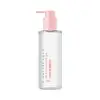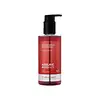What's inside
What's inside
 Key Ingredients
Key Ingredients

 Benefits
Benefits

 Concerns
Concerns

No concerns
 Ingredients Side-by-side
Ingredients Side-by-side

Cetyl Ethylhexanoate
EmollientSorbeth-30 Tetraoleate
EmulsifyingCaprylic/Capric Triglyceride
MaskingHelianthus Annuus Seed Oil
EmollientOryza Sativa Bran Oil
EmollientLactobacillus/Soymilk Ferment Filtrate
Skin ConditioningCapryloyl Salicylic Acid
ExfoliatingSaccharomyces/Rice Ferment Filtrate
Skin ConditioningSaponaria Officinalis Leaf Extract
AntimicrobialTocopherol
AntioxidantButylene Glycol
HumectantPentylene Glycol
Skin ConditioningWater
Skin ConditioningCaprylyl Glycol
Emollient1,2-Hexanediol
Skin ConditioningCetyl Ethylhexanoate, Sorbeth-30 Tetraoleate, Caprylic/Capric Triglyceride, Helianthus Annuus Seed Oil, Oryza Sativa Bran Oil, Lactobacillus/Soymilk Ferment Filtrate, Capryloyl Salicylic Acid, Saccharomyces/Rice Ferment Filtrate, Saponaria Officinalis Leaf Extract, Tocopherol, Butylene Glycol, Pentylene Glycol, Water, Caprylyl Glycol, 1,2-Hexanediol
Ethylhexyl Palmitate
EmollientSorbeth-30 Tetraoleate
EmulsifyingIsopropyl Palmitate
EmollientCetyl Ethylhexanoate
EmollientTriethylhexanoin
MaskingCaprylic/Capric Triglyceride
MaskingDiisostearyl Malate
EmollientSorbitan Sesquioleate
EmulsifyingParfum
MaskingLithospermum Erythrorhizon Root Extract
Skin ConditioningCaprylyl Glycol
EmollientEthylhexylglycerin
Skin ConditioningWater
Skin ConditioningArgania Spinosa Kernel Oil
EmollientCitrus Junos Fruit Oil
MaskingGlycine Max Oil
EmollientGlycine Soja Oil
EmollientOryza Sativa Bran Oil
EmollientPanax Ginseng Seed Oil
EmollientPropanediol
SolventPrunus Amygdalus Dulcis Oil
Skin ConditioningPunica Granatum Seed Oil
EmollientPyrus Malus Seed Oil
EmollientSimmondsia Chinensis Seed Oil
EmollientCamellia Japonica Seed Oil
EmollientAllantoin
Skin ConditioningAzelaic Acid
BufferingCapryloyl Salicylic Acid
ExfoliatingGluconolactone
Skin ConditioningMandelic Acid
AntimicrobialPropylene Glycol
HumectantSalicylic Acid
MaskingSqualane
EmollientPentylene Glycol
Skin ConditioningAdansonia Digitata Seed Oil
EmollientButylene Glycol
HumectantCamellia Oleifera Seed Oil
Skin ConditioningCarthamus Tinctorius Seed Oil
MaskingHelianthus Annuus Seed Oil
EmollientHippophae Rhamnoides Oil
EmollientMadecassoside
AntioxidantOlea Europaea Fruit Oil
MaskingPersea Gratissima Oil
Skin ConditioningPrunus Armeniaca Kernel Oil
MaskingRibes Nigrum Seed Oil
Emollient1,2-Hexanediol
Skin ConditioningDecyl Glucoside
CleansingCentella Asiatica Extract
CleansingMelaleuca Alternifolia Leaf Extract
PerfumingPhospholipids
Skin ConditioningRetinol
Skin ConditioningEthylhexyl Palmitate, Sorbeth-30 Tetraoleate, Isopropyl Palmitate, Cetyl Ethylhexanoate, Triethylhexanoin, Caprylic/Capric Triglyceride, Diisostearyl Malate, Sorbitan Sesquioleate, Parfum, Lithospermum Erythrorhizon Root Extract, Caprylyl Glycol, Ethylhexylglycerin, Water, Argania Spinosa Kernel Oil, Citrus Junos Fruit Oil, Glycine Max Oil, Glycine Soja Oil, Oryza Sativa Bran Oil, Panax Ginseng Seed Oil, Propanediol, Prunus Amygdalus Dulcis Oil, Punica Granatum Seed Oil, Pyrus Malus Seed Oil, Simmondsia Chinensis Seed Oil, Camellia Japonica Seed Oil, Allantoin, Azelaic Acid, Capryloyl Salicylic Acid, Gluconolactone, Mandelic Acid, Propylene Glycol, Salicylic Acid, Squalane, Pentylene Glycol, Adansonia Digitata Seed Oil, Butylene Glycol, Camellia Oleifera Seed Oil, Carthamus Tinctorius Seed Oil, Helianthus Annuus Seed Oil, Hippophae Rhamnoides Oil, Madecassoside, Olea Europaea Fruit Oil, Persea Gratissima Oil, Prunus Armeniaca Kernel Oil, Ribes Nigrum Seed Oil, 1,2-Hexanediol, Decyl Glucoside, Centella Asiatica Extract, Melaleuca Alternifolia Leaf Extract, Phospholipids, Retinol
 Reviews
Reviews

Ingredients Explained
These ingredients are found in both products.
Ingredients higher up in an ingredient list are typically present in a larger amount.
1,2-Hexanediol is a synthetic liquid and another multi-functional powerhouse.
It is a:
- Humectant, drawing moisture into the skin
- Emollient, helping to soften skin
- Solvent, dispersing and stabilizing formulas
- Preservative booster, enhancing the antimicrobial activity of other preservatives
Butylene Glycol (or BG) is used within cosmetic products for a few different reasons:
Overall, Butylene Glycol is a safe and well-rounded ingredient that works well with other ingredients.
Though this ingredient works well with most skin types, some people with sensitive skin may experience a reaction such as allergic rashes, closed comedones, or itchiness.
Learn more about Butylene GlycolThis ingredient is an emollient, solvent, and texture enhancer. It is considered a skin-softener by helping the skin prevent moisture loss.
It helps thicken a product's formula and makes it easier to spread by dissolving clumping compounds.
Caprylic Triglyceride is made by combining glycerin with coconut oil, forming a clear liquid.
While there is an assumption Caprylic Triglyceride can clog pores due to it being derived from coconut oil, there is no research supporting this.
Learn more about Caprylic/Capric TriglycerideCapryloyl Salicylic Acid comes from salicylic acid, the famous acne-fighting BHA.
It usually goes by a more common name of LHA, or lipohydroxy acid.
Like salicylic acid, this ingredient is a chemical exfoliant that can help break down the oil in your pores and reduce inflammation.
Though studies for LHA do show it to be less effective than salicylic acid. To be fair, salicylic acid is the reigning monarch of acne treatments.
However, a study from 2009 found LHA to be comparable to BPO, making it a good alternative for people with sensitive skin. Another study of 14 patients found a significant decrease in comedones after using LHA.
Another pro of LHA? It is less irritating than salicylic acid due to its large molecule size.
Large molecules cannot penetrate skin as well, so they are gentler on the skin. LHA is much less penetrative than salicylic acid.
An in-vitro study (not done on a living organism) found only 6% of LHA penetrated past the statum corneum compared to 58% of salicylic acid. An in-vivo (done on a living organism) analysis revealed ~17% of LHA was still present in the top layer of skin after 4 days, versus ~9% of salicylic acid.
Interestingly, a study from 2008 found LHA comparable to another famous acid, glycolic acid.
This study found about 10% of LHA is as effective as 20-50% of glycolic acid in treating hyperpigmentation and fine-lines.
Hydroxy acids have been found to stimulate skin protein, lipids, and thermal thickening. This may have anti-aging benefits.
Learn more about Capryloyl Salicylic AcidCaprylyl Glycol is a humectant and emollient, meaning it attracts and preserves moisture.
It is a common ingredient in many products, especially those designed to hydrate skin. The primary benefits are retaining moisture, skin softening, and promoting a healthy skin barrier.
Though Caprylyl Glycol is an alcohol derived from fatty acids, it is not the kind that can dry out skin.
This ingredient is also used as a preservative to extend the life of products. It has slight antimicrobial properties.
Learn more about Caprylyl GlycolCetyl Ethylhexanoate is an emollient ester. It comes from cetearyl alcohol and 2-ethylhexanoic acid.
Cetyl Ethylhexanoate is an emollient that adds a velvety feel to skin without being greasy or oily. Emollients help trap moisture into your skin, keeping your skin soft and hydrated.
Helianthus Annuus Seed Oil is the oil derived from the seeds of a Sunflower. Sunflower seed oil is non-fragrant. It is an emollient, meaning it helps to soften the skin.
Sunflower seed oil contains many fatty acids. The fatty acids found in sunflower seeds include (from highest amount to least): linoleic acid, myristic acid, palmitic acid, stearic acid, arachidic acid, oleic acid, and linolenic acid.
These fatty acids help the skin create ceramides. Ceramides play a role in repairing the skin barrier.
Helianthus Annuus Seed Oil helps moisturize the skin. This in turn helps the skin look more rejuvenated and smoother.
Sunflowers are rich in vitamin E.
Historians believe Indigenous cultures of North America domesticated sunflowers before corn. Thus they relied on sunflower oil for a variety of uses. One such use is moisturizing skin and hair.
Sunflower seed oil may not be fungal acne safe. We recommend speaking with a professional if you have any concerns.
Learn more about Helianthus Annuus Seed OilOryza Sativa Bran Oil comes from the outer layer of a rice kernel. It is a byproduct of milling rice, or the operation to produce a whole grain rice product.
This ingredient has emollient and skin conditioning properties. This is due to its polysaccharides and omega-3 fatty acids.
Emollients help soothe and soften the skin. It does this by creating a protective film on your skin. This barrier helps trap moisture and keeps your skin hydrated.
Learn more about Oryza Sativa Bran OilPentylene glycol is typically used within a product to thicken it. It also adds a smooth, soft, and moisturizing feel to the product. It is naturally found in plants such as sugar beets.
The hydrophilic trait of Pentylene Glycol makes it a humectant. As a humectant, Pentylene Glycol helps draw moisture from the air to your skin. This can help keep your skin hydrated.
This property also makes Pentylene Glycol a great texture enhancer. It can also help thicken or stabilize a product.
Pentylene Glycol also acts as a mild preservative and helps to keep a product microbe-free.
Some people may experience mild eye and skin irritation from Pentylene Glycol. We always recommend speaking with a professional about using this ingredient in your routine.
Pentylene Glycol has a low molecular weight and is part of the 1,2-glycol family.
Learn more about Pentylene GlycolSorbeth-30 Tetraoleate is a surfactant and emulsifier.
This ingredient is a tetraester from oleic acid and polyethylene glycol ether of sorbitol.
As an emulsifier, it helps ingredients such as oil and water mix together. This allows the dirt and oils in your skin to be washed away.
One study found pumpkin oil containing Sorbeth-30 Tetraoleate helped hydrate the skin and did not cause any irritation.
Learn more about Sorbeth-30 TetraoleateWater. It's the most common cosmetic ingredient of all. You'll usually see it at the top of ingredient lists, meaning that it makes up the largest part of the product.
So why is it so popular? Water most often acts as a solvent - this means that it helps dissolve other ingredients into the formulation.
You'll also recognize water as that liquid we all need to stay alive. If you see this, drink a glass of water. Stay hydrated!
Learn more about Water